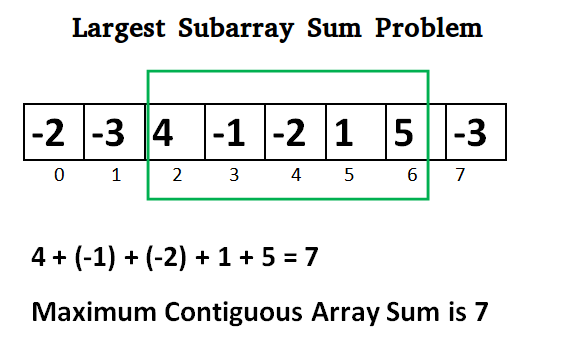最大和连续子数组的Python程序
编写一个高效的程序,在具有最大和的一维数字数组中找到连续子数组的和。

Kadane算法:
Initialize:
max_so_far = INT_MIN
max_ending_here = 0
Loop for each element of the array
(a) max_ending_here = max_ending_here + a[i]
(b) if(max_so_far < max_ending_here)
max_so_far = max_ending_here
(c) if(max_ending_here < 0)
max_ending_here = 0
return max_so_far解释:
Kadane 算法的简单思想是查找数组的所有正连续段(max_ending_here 用于此)。并跟踪所有正段之间的最大和连续段(max_so_far 用于此)。每次我们得到一个正和时,将它与 max_so_far 进行比较,如果它大于 max_so_far 则更新 max_so_far
Lets take the example:
{-2, -3, 4, -1, -2, 1, 5, -3}
max_so_far = max_ending_here = 0
for i=0, a[0] = -2
max_ending_here = max_ending_here + (-2)
Set max_ending_here = 0 because max_ending_here < 0
for i=1, a[1] = -3
max_ending_here = max_ending_here + (-3)
Set max_ending_here = 0 because max_ending_here < 0
for i=2, a[2] = 4
max_ending_here = max_ending_here + (4)
max_ending_here = 4
max_so_far is updated to 4 because max_ending_here greater
than max_so_far which was 0 till now
for i=3, a[3] = -1
max_ending_here = max_ending_here + (-1)
max_ending_here = 3
for i=4, a[4] = -2
max_ending_here = max_ending_here + (-2)
max_ending_here = 1
for i=5, a[5] = 1
max_ending_here = max_ending_here + (1)
max_ending_here = 2
for i=6, a[6] = 5
max_ending_here = max_ending_here + (5)
max_ending_here = 7
max_so_far is updated to 7 because max_ending_here is
greater than max_so_far
for i=7, a[7] = -3
max_ending_here = max_ending_here + (-3)
max_ending_here = 4程序:
Python3
# Python program to find maximum contiguous subarray
# Function to find the maximum contiguous subarray
from math import inf
maxint=inf
def maxSubArraySum(a,size):
max_so_far = -maxint - 1
max_ending_here = 0
for i in range(0, size):
max_ending_here = max_ending_here + a[i]
if (max_so_far < max_ending_here):
max_so_far = max_ending_here
if max_ending_here < 0:
max_ending_here = 0
return max_so_far
# Driver function to check the above function
a = [-13, -3, -25, -20, -3, -16, -23, -12, -5, -22, -15, -4, -7]
print ("Maximum contiguous sum is", maxSubArraySum(a,len(a)))
#This code is contributed by _Devesh Agrawal_Python3
def maxSubArraySum(a,size):
max_so_far = a[0]
max_ending_here = 0
for i in range(0, size):
max_ending_here = max_ending_here + a[i]
if max_ending_here < 0:
max_ending_here = 0
# Do not compare for all elements. Compare only
# when max_ending_here > 0
elif (max_so_far < max_ending_here):
max_so_far = max_ending_here
return max_so_farPython3
# Python program to find maximum contiguous subarray
def maxSubArraySum(a,size):
max_so_far =a[0]
curr_max = a[0]
for i in range(1,size):
curr_max = max(a[i], curr_max + a[i])
max_so_far = max(max_so_far,curr_max)
return max_so_far
# Driver function to check the above function
a = [-2, -3, 4, -1, -2, 1, 5, -3]
print("Maximum contiguous sum is" , maxSubArraySum(a,len(a)))
#This code is contributed by _Devesh Agrawal_Python3
# Python program to print largest contiguous array sum
from sys import maxsize
# Function to find the maximum contiguous subarray
# and print its starting and end index
def maxSubArraySum(a,size):
max_so_far = -maxsize - 1
max_ending_here = 0
start = 0
end = 0
s = 0
for i in range(0,size):
max_ending_here += a[i]
if max_so_far < max_ending_here:
max_so_far = max_ending_here
start = s
end = i
if max_ending_here < 0:
max_ending_here = 0
s = i+1
print ("Maximum contiguous sum is %d"%(max_so_far))
print ("Starting Index %d"%(start))
print ("Ending Index %d"%(end))
# Driver program to test maxSubArraySum
a = [-2, -3, 4, -1, -2, 1, 5, -3]
maxSubArraySum(a,len(a))输出:
Maximum contiguous sum is 7另一种方法:
Python3
def maxSubArraySum(a,size):
max_so_far = a[0]
max_ending_here = 0
for i in range(0, size):
max_ending_here = max_ending_here + a[i]
if max_ending_here < 0:
max_ending_here = 0
# Do not compare for all elements. Compare only
# when max_ending_here > 0
elif (max_so_far < max_ending_here):
max_so_far = max_ending_here
return max_so_far
时间复杂度: O(n)
算法范式:动态规划
以下是Mohit Kumar建议的另一个简单实现。当数组中的所有数字都是负数时,该实现会处理这种情况。
Python3
# Python program to find maximum contiguous subarray
def maxSubArraySum(a,size):
max_so_far =a[0]
curr_max = a[0]
for i in range(1,size):
curr_max = max(a[i], curr_max + a[i])
max_so_far = max(max_so_far,curr_max)
return max_so_far
# Driver function to check the above function
a = [-2, -3, 4, -1, -2, 1, 5, -3]
print("Maximum contiguous sum is" , maxSubArraySum(a,len(a)))
#This code is contributed by _Devesh Agrawal_
输出:
Maximum contiguous sum is 7为了打印具有最大和的子数组,我们在获得最大和时维护索引。
Python3
# Python program to print largest contiguous array sum
from sys import maxsize
# Function to find the maximum contiguous subarray
# and print its starting and end index
def maxSubArraySum(a,size):
max_so_far = -maxsize - 1
max_ending_here = 0
start = 0
end = 0
s = 0
for i in range(0,size):
max_ending_here += a[i]
if max_so_far < max_ending_here:
max_so_far = max_ending_here
start = s
end = i
if max_ending_here < 0:
max_ending_here = 0
s = i+1
print ("Maximum contiguous sum is %d"%(max_so_far))
print ("Starting Index %d"%(start))
print ("Ending Index %d"%(end))
# Driver program to test maxSubArraySum
a = [-2, -3, 4, -1, -2, 1, 5, -3]
maxSubArraySum(a,len(a))
输出:
Maximum contiguous sum is 7
Starting index 2
Ending index 6Kadane 的算法既可以被视为贪心算法,也可以被视为 DP。正如我们所看到的,我们正在保持整数的运行总和,当它小于 0 时,我们将其重置为 0(贪婪部分)。这是因为继续负总和比重新开始新范围更糟糕。现在它也可以被视为一个 DP,在每个阶段我们有 2 个选择:要么获取当前元素并继续之前的总和,要么重新开始一个新的范围。这两个选择都在实施过程中得到照顾。
时间复杂度: O(n)
辅助空间: O(1)
现在试试下面的问题
给定一个整数数组(可能某些元素为负数),编写一个 C 程序,通过将数组中 n ≤ ARRAY_SIZE 的“n”个连续整数相乘,找出*最大乘积*。另外,打印最大乘积子数组的起点。